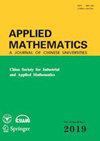动态随机图的Estrada指数
IF 1
4区 数学
Applied Mathematics-A Journal of Chinese Universities Series B
Pub Date : 2023-06-23
DOI:10.1007/s11766-023-3727-7
引用次数: 1
摘要
n个顶点上的图G的Estrada指数由\(EE(G) = \sum\nolimits_{i = 1}^n {{e^{{\lambda _i}}}} \)定义,其中λ1, λ2,⋯λn是G的邻接特征值。我们定义了两种根据连续时间马尔可夫过程进化的一般类型的动态图,它们的平稳分布分别与Erdös-Rényi随机图和给定期望度的随机图匹配。我们给出了这些动态图的Estrada指数的一些新的估计和上界和下界。本文章由计算机程序翻译,如有差异,请以英文原文为准。
Estrada index of dynamic random graphs
The Estrada index of a graph G on n vertices is defined by \(EE(G) = \sum\nolimits_{i = 1}^n {{e^{{\lambda _i}}}} \), where λ1, λ2, ⋯, λn are the adjacency eigenvalues of G. We define two general types of dynamic graphs evolving according to continuous-time Markov processes with their stationary distributions matching the Erdös-Rényi random graph and the random graph with given expected degrees, respectively. We formulate some new estimates and upper and lower bounds for the Estrada indices of these dynamic graphs.
求助全文
通过发布文献求助,成功后即可免费获取论文全文。
去求助
来源期刊

Applied Mathematics-A Journal of Chinese Universities Series B
MATHEMATICS, APPLIED-
自引率
10.00%
发文量
33
期刊介绍:
Applied Mathematics promotes the integration of mathematics with other scientific disciplines, expanding its fields of study and promoting the development of relevant interdisciplinary subjects.
The journal mainly publishes original research papers that apply mathematical concepts, theories and methods to other subjects such as physics, chemistry, biology, information science, energy, environmental science, economics, and finance. In addition, it also reports the latest developments and trends in which mathematics interacts with other disciplines. Readers include professors and students, professionals in applied mathematics, and engineers at research institutes and in industry.
Applied Mathematics - A Journal of Chinese Universities has been an English-language quarterly since 1993. The English edition, abbreviated as Series B, has different contents than this Chinese edition, Series A.
 求助内容:
求助内容: 应助结果提醒方式:
应助结果提醒方式:


